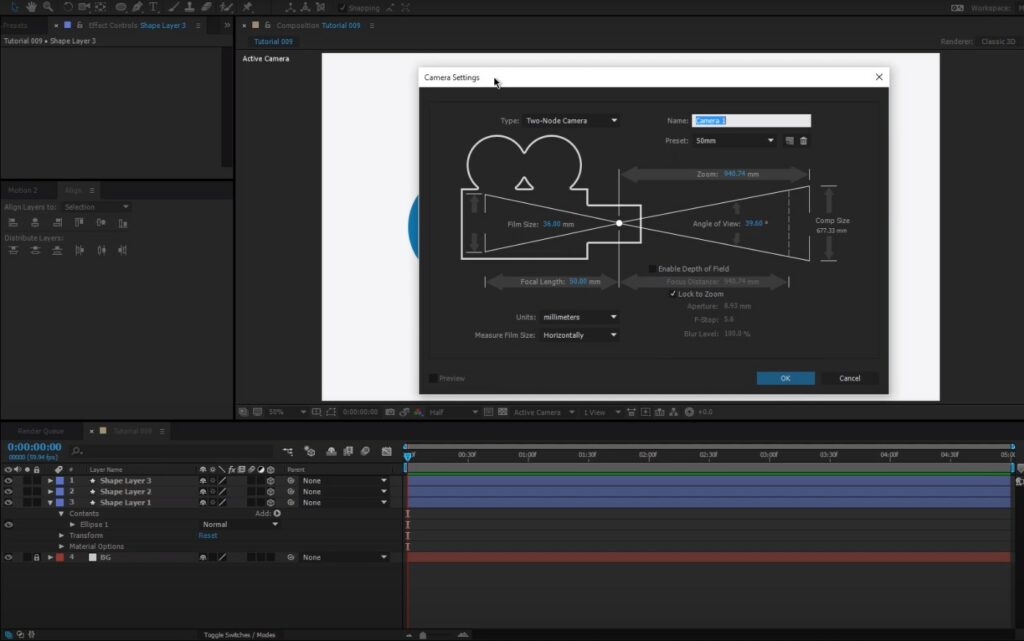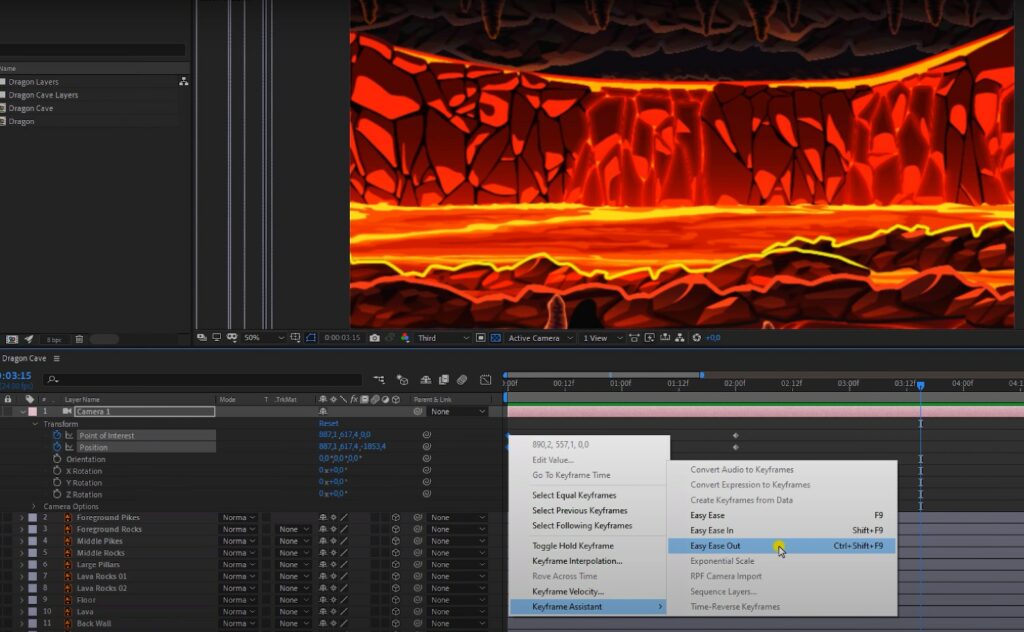Exploring the Camera Feature in Adobe After Effects
After Effects (AE) reigns supreme in the realm of video production projects, proving itself as a formidable tool for content creators. It offers an arsenal of features that empowers you to craft intricate animations and graphics in record time. At the heart of these advanced capabilities lies the Camera function, a tool of paramount importance for producing professional-grade videos.
This article aims to provide a detailed insight into the function’s use in AE, helping you transform your video production process and elevate the quality of your projects.
Delving Into the Fundamentals of the After Effects Camera
The cam function in AE is akin to a magic wand, enabling you to weave breathtaking visual effects and animations. Mirroring the role of a cam on a real-world set, it allows you to emulate intricate cam movements, capture footage, and navigate within a virtual environment. This potent tool enables you to craft dynamic maneuvers, dive into and pull out of a scene, and produce stunning visual effects that can infuse life into your projects.
Your primary point of interaction will be with Camera Layers that serve as virtual cameras, letting you position and animate within a composition. They act as your director’s lens, granting you the power to choose and control the cam capturing your project.
Note that before venturing into using the tool in your AE composition, creating and establishing a Layer is crucial.
Decoding the Different Types of Cameras in After Effects
In After Effects, you have three cam options at your disposal – a One-Node, Two-Node, and Three-Node Camera. Each type comes with distinctive features, making them apt for various video projects:
- The One-Node is the simplest of the trio. With only one node, its movements and rotations are limited to one direction, making it an excellent choice for straightforward projects;
- The Two-Node option steps up the complexity level, with two nodes allowing movements and rotations in two directions. This versatility makes it more advanced than the One-Node option;
- The Three-Node is the most sophisticated option in AE. With three nodes, it offers the flexibility to move and rotate in three directions, opening up a world of possibilities for complex projects.
Keep in mind that your choice can make or break your project. For simple projects, the One-Node cam’s straightforward operation might suffice. However, for more complex projects demanding advanced maneuvers, opting for the Two-Node or Three-Node option can be a wise decision.

Your project’s complexity and requirements should guide your choice of the cam type, ensuring that you get the most out of AE.
Steering Through the Camera Tools in After Effects
Mastering the art of navigating cam settings in AE hinges upon the understanding and usage of the Camera Tools function. This functionality lets you scrutinize the settings and maneuver within the virtual environment through the Tools menu. Accessible from the composition window under viewing options, the Tools function encompasses the Orbit Camera tool, the Pan Behind tool, and other vital tools.
The Orbit Tool facilitates the rotation of the camera around the scene. It’s your go-to tool for sculpting dynamic movements and viewing your scene from a multitude of angles. In contrast, the Pan Behind tool is responsible for navigating the cam around the scene, creating a smooth flow and perfect positioning.
Crafting Your Camera Settings in After Effects
Establishing your cam in AE is one of the preliminary and most crucial steps when exploiting this feature. A layer is a non-negotiable requirement for constructing a three-dimensional environment and instilling depth in your composition.
We’ll steer you through the creation of a Layer, fine-tuning of the Settings, and selection of the optimal cam type for your project.
Step-by-Step Guide to Creating a Camera Layer
The process of creating a Layer is fairly straightforward:
- Begin by navigating to the Composition window. Click on Layer, and select the New Camera option. This action triggers a dialog box, where you can choose your preferred cam type and input the required settings. You can choose a One-Node or Two-Node camera or even a custom type based on your needs;
- Once the type is chosen, it’s time to tweak the settings to align with your project’s demands. You can modify the Angle, Zoom, Lens, and other settings to craft the ideal Layer for your composition.
Tailoring Your Camera Settings to Fit Your Project
Fine-tuning your settings is an integral part of sculpting a layer that mirrors your project requirements. The Camera settings in AE span across Aperture, Focal Length, Depth of Field, and more. These adjustments enable you to refine your Camera Layer, adding an additional layer of depth to your composition.
For instance, by tweaking the Aperture setting, you can alter the depth of field in your composition, enhancing its realism. Similarly, modifying the Focal Length can drastically change your cam’s perspective, making the subject appear either closer or further away. These controls offer you the flexibility to tailor your project’s visual appeal, elevating its overall impact.
Breathing Depth into Your Project: Animating Depth of Field
The Depth of Field effect holds the power to blur the background image of your composition, rendering it a shallow depth of field appearance. Applying this effect to the Camera spawns a natural blur, mimicking the focus that naturally happens when snapping a photo or filming a video.
Consider you’re creating a video of an individual ambling through a park. By leveraging the Depth of Field effect, you can blur the backdrop and concentrate on the person. This method cultivates a sense of closeness and focus, making the viewer feel as if they are sharing the stroll with the individual.

Animating the Camera in AE stands as a potent instrument for introducing motion, depth, and intrigue to your video projects. Whether your project is a video walk-through, a city skyline, or a celestial body in space, animation can vivify your project and captivate your audience.
- Transforming your Design Perspective with 3D Layers: In After Effects, you’re empowered to morph layers from 2D to 3D and position them in your scene using the Camera;
- Transitioning from 2D to 3D: To morph 2D Layers into 3D, choose the layer and click on the 3D Layer Icon at the lower end of the Layers Panel. This action transmutes the 2D layer into a 3D layer, equipping it to be positioned in the 3D space;
- Creating your 3D Universe: Post the transformation to 3D, and you can place your layers in the 3D space using the Camera. The Camera Tool menu nestled in the Composition window offers a plethora of tools to assist you in this task, including the indispensable Orbit Camera Tool and the Pan Behind Tool;
- Visualizing your 3D Landscape: Lastly, to witness the unfolding of your 3D scene, you can harness the 3D Views option in the Composition window. This feature provides multiple viewpoints of your composition that can be utilized to preview and refine your work, thus simplifying your composition enhancement process.
Summarizing Table
| Key Concepts | Key Takeaways |
|---|---|
| Camera Feature in AE | The cam function mimics real-world mechanics, enabling the simulation of complex movements in a virtual environment. This feature is pivotal in creating professional-level videos. |
| Cam Types in AE | There are three types: One-Node, Two-Node, and Three-Node. Each type has unique features and should be chosen based on project complexity. |
| Tools Navigation | The tools include the Orbit Camera Tool and the Pan Behind Tool. They allow navigation in the virtual environment, rotation of the cam around the scene, and moving it in the background. |
| Setting Up a Cam in AE | Creating a layer, adjusting the settings, and selecting an appropriate cam type are necessary steps to establish the camera in AE. |
| Animating the Cam | Keyframing cam movements and using the Orbit tool effectively animate the cam, adding movement and depth to video projects. |
| Animating Depth of Field | This animation blurs the background image of your composition, creating a natural focus on the main subject. It contributes to a sense of intimacy and focus. |
| Working with 3D Layers | Converting 2D layers to 3D layers allows the positioning of these layers in a 3D space. Utilizing the 3D Views option helps in previewing and refining your composition. |
Conclusion
The Camera feature in E emerges as a critical tool for weaving intricate animations and graphics. Grasping its usage is crucial to fabricate professional-grade videos.
With the steps delineated in this article, you should now feel poised to use the Camera in AE and create sophisticated camera movements that amplify the allure of your video projects.
